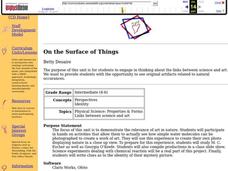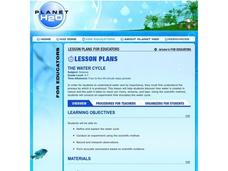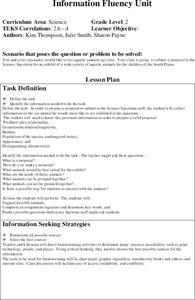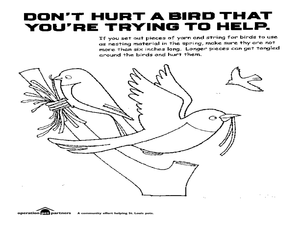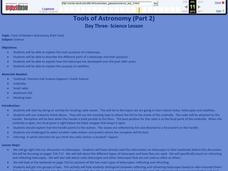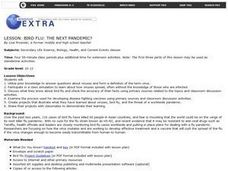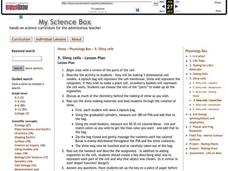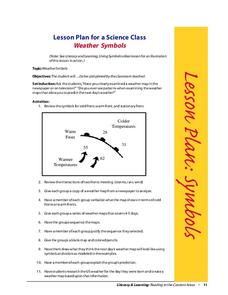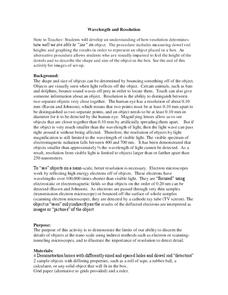Field Museum
The Case of Darwin's Finches
One of the most striking pieces of evidence for Darwin's Evolution of Species was his observations of finches and how their beaks differed from island to island, depending on their primary food sources. So what would happen to the theory...
Curated OER
Edible Model of the Sun
Young scholars identify the different features of the Sun. In this space science lesson, students create a model of its surface using cookies and candies. They compare and contrast their model to the real Sun.
Curated OER
On the Surface of Things
Students create a Claris slide shows from pictures they have taken of items close-up in nature after studying the works of M.C. Escher and Georgia O'Keefe. Slide shows includes captions for clues to the identity of their nature picture.
Curated OER
Planning An Escape Plan
Students participate in a mock fire escape plan in this lesson plan. They identify the reasons for remaining calm, closing doors, ad testing doors between rooms and the main exits. They also watch a experiment that demonstrates what...
Curated OER
How Do You Know There is Air in a Bag?
Fourth graders explore air as a material substance. Through experimentation and discussion, they explore how air can be classified as a material substance. Students write three examples proving that air is a material substance in their...
Curated OER
The Water Cycle
Students research the water cycle and identify main vocabulary associated with the water cycle. They build and observe a closed system model that demonstrates the water cycle in action.
Curated OER
Information Fluency Unit
Second graders create a proposal for the Science Spectrum to have an exhibit of a wide variety of aquatic animals for the children of the South Plains. These students would like to see aquatic animals up close.
Curated OER
This is for the Birds!
Learners complete activities to investigate wild birds. For this bird study lesson, students make a wild bird feeder to examine the proper ways to care for wild birds. Learners explore organizations in their community that help wild...
Curated OER
Sleuth Rays
Students conduct a close examination of the atom's electrons, and discover how to theorize the energy levels, observe the brightness of light, classify colors, and measure temperature.
Curated OER
Tools of Modern Astronomy
Students differentiate refracting and reflecting telescopes. In this earth science lesson, students explain how they are closely connected to satellites. They complete the concept map at the end of the activity.
Curated OER
From Seed to Bread
Students examine how some of their food comes from plants by baking bread. They listen to teacher read alouds that set the stage for the activity.
Curated OER
Rocking the Boat
Students work together to discover the concepts of stability and equilibrium. They examine how equilibrium is related to an item's center of mass. They create their own action scene in a literacy activity.
Curated OER
Modelling Ocean Currents
Students construct a replica of the Atlantic ocean given certain parameters. In this earth science instructional activity, students draw their own map of ocean currents. They answer questions related to the activity.
Curated OER
Bird Flu: the Next Pandemic?
Students discuss what they know about bird flu and check the accuracy of their facts using primary sources related to the topics and classroom discussion activities. They create projects that illustrate what they have learned about...
Curated OER
Series and Parallel Circuits
Young scholars examine electricity. For this circuits lesson students complete an activity that shows them the configuration of circuits.
Curated OER
Decomposers at Work!
Students design and conduct investigations that illustrate the process of decomposition. After a lecture/demo, students simulate the process of soil composting in the classroom. They closely chart the decomposition of their soil.
Curated OER
Does the Seed Matter?
Students compare the growth of watermelon from commercial seeds and those harvested from a watermelon. They complete science journals showing these comparisons based on the data they collect.
Curated OER
Slimy cells
Students study the parts of a cell. In this chemistry instructional activity students complete an activity in which they make as much slime as they want.
Curated OER
Bird Beak Buffet
Students complete an activity that allows them to better understand that birds traits are closely related to what they eat, where they live, etc. In this bird trait lesson students complete an activity, create a data board and...
Curated OER
Weather Symbols
Young scholars study weather symbols. In this weather symbols lesson, students review the symbols for cold, warm, and stationary fronts. Young scholars use a weather map to study the weather symbols, complete a weather illustration and...
Curated OER
Pollution Solutions
Students participate in a hands-on activity to determine how water is polluted and investigate steps in how to treat water. Students try to produce the cleanest water possible using the materials provided.
Curated OER
Wavelength And Resolution
High schoolers perform a simulation of the workings of an electron microscope to discover that the resolution will need to improved to detect objects in the nano-scale. They use wooden dowels as detectors to determine the shape of...
Curated OER
Map Field of Current
Students determine that moving charges create a magnetic field. They discover that the speed and direction of motion, the amount of charge, and the deflection angle observed are closely linked. A voltmeter, pendulum, and a constructed...
Curated OER
Crocodile Eyes
Students investigate the eyes and eyelids of reptiles and amphibians. In this animal biology lesson, students listen to a lecture on the characteristics of amphibians and reptiles and complete a crocodile eyelid activity sheet.


